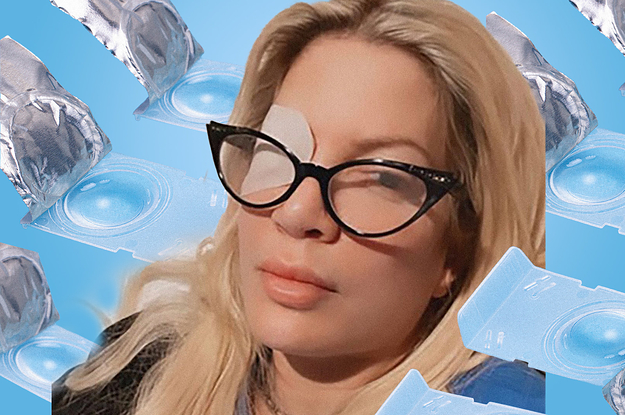Tori Spelling Said She Sometimes Sleeps In Contacts For 20 Days Straight. Here’s What That Does To Your Eyes.
“I have contacts, but I wear daily ones, and at the end of the day I can make all the excuses I want. I don’t take them out. I sleep in them. It’s not healthy. You’re supposed to change them,” Spelling told her co-star.
Since one-third of people wear contact lenses, there’s a possibility that you’ve fallen asleep with your contacts in, like Spelling.
However, serious complications can develop if you sleep or nap in contact lenses, even if the contacts are labeled as “extended wear.” Serious eye infections can lead to blindness, and affect 1 out of 500 people who wear contact lenses each year.
With around 40% to 90% of people not following the proper care instructions for their contact lenses, we asked eye experts when you should take out your contact lenses and the dos and don’ts of contact wearing.
Sleeping in lenses can be dangerous — even just a nap
Arvind Saini, a clinical spokesperson for the American Academy of Ophthalmology, told BuzzFeed News that sleeping in contact lenses increases the risk of getting an eye infection, as a result of the lack of oxygen getting to your eyes.
“Normally, without contact lenses, oxygen and nutrients can easily get to the skin on the surface of the eye, because it is coated with tears,” Saini said. When you blink, you replenish the tear layer that coats the surface of the eye.”
Most people can safely wear contacts for up to 14 to 16 hours at a time. While awake, blinking allows the eyes to be moisturized, which protects the surface. However, when the eyes are closed, there’s no oxygen or moisture to protect the eyes. Without moisture, or tears, there is an increased risk of eye infections, as well as severe dry eyes, eye inflammation, ulcers, and vision loss.
“If you sleep in your contact lenses, you are keeping a bacteria-laden piece of plastic pressed against the cornea,” Saini said. “In an environment with less tear exchange and oxygen present to protect the surface of the eye — it is a recipe for disaster.”
Although newer contact lenses might be advertised as extended wear with increased oxygen permeability and less drying, there are still risks associated with sleeping in these lenses. The manufacturers of extended-wear contacts say you can wear them continuously for a week or month (depending on the type), and even sleep in them, but the experts we talked to said it’s probably better to take them out at night.
“The skin layer will be damaged less when you wear them,” Saini said. “However, the skin layer will still be stressed from the contact lens and breaks can occur in the protective barrier.”
All contact lenses, whether they are dailies, weeklies, or meant for longer wear, should be taken out at the end of the day or as recommended. If they are dailies, you throw them out; with other types you can put them back in the next day — but you shouldn’t sleep in them if you can help it.
A corneal ulcer is a vision-threatening infection
A corneal ulcer, or keratitis, is an open sore on the cornea, which is the transparent part of the eye that covers the iris and pupil. The ulcer may or may not be visible to the naked eye (it can look like a white spot), and it can be caused by bacteria, viruses, or parasites, or by an eye injury. The symptoms can include eye pain, blurry vision, and photophobia, or eye discomfort in bright light.
A corneal ulcer and pink eye, a common eye infection, can have overlapping symptoms, including red and teary eyes. However, unlike pink eye, a corneal ulcer affects the surface of the eye and can impair vision if not treated. (In the podcast, Spelling said people asked her if she had pink eye.)
A corneal ulcer is generally treated with antibiotics, antiviral, or antifungal drops, and with a protective eye patch.
You can reduce your risk of an infection by 60 to 70% by not sleeping in your contacts.
Contact lenses: Dos
“Contact lens–related eye infections and other injuries can lead to long-lasting damage but often are preventable. [There are] many common care mistakes, including failing to clean and store lenses as directed by a doctor of optometry,” said Robert C. Layman, the immediate past president of the American Optometric Association.
- Wash your hands before and after putting in and taking out your contacts to avoid the transfer of bacteria.
- Clean your contact lens case or replace them every three months. Cases can contain biofilm and debris. (A biofilm is a slimy layer of bacteria.)
- Remove your contacts before swimming or showering.
- Remove contacts if your eyes become irritated, red, or if your vision becomes worse.
- Follow the exact steps on your contact lens packaging.
Contact lenses: Don’ts
“If your contacts are not approved for continuous overnight use, you are putting yourself at risk for potential eye and vision damage,” Layman said. “Even those contact lenses that are approved for continuous overnight use deprive your eyes of oxygen and should be taken out regularly to give your eyes a break and a chance to breathe.”
You should try not to:
- Wear your contacts for longer than 14 to 16 hours.
- Wear 30-day, daily, or really any contacts overnight.
- Continue wearing contact lenses day after day in a way that’s not recommended.
- Store or clean your lenses in tap water. It’s not sterile!
- Reuse contact lens saline solution.
“In general, we do not want to keep bacteria in close contact with the surface of the eye, especially if there are open breaks in the surface of the eye,” Saini said. “Microorganisms can grow and thrive on contact lenses. Our skin barrier is important to prevent bacteria from entering and causing an infection. Similarly, the surface of the eye is covered with a transparent skin layer that protects deeper layers of the cornea from infection.”







